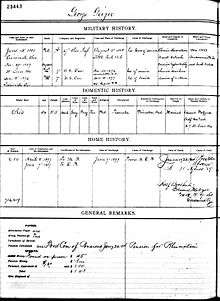George Geiger
| George Geiger | |
|---|---|
| Born |
1843 Cincinnati, Ohio |
| Died | 1904 (aged 60–61) |
| Place of burial | Dayton National Cemetery, Ohio |
| Allegiance | United States of America |
| Service/branch | United States Army |
| Years of service | 1861 - 1865, 1867 - 1877 |
| Rank | Sergeant |
| Unit | Company H, 7th United States Cavalry |
| Battles/wars | Battle of the Little Big Horn |
| Awards | Medal of Honor |
George Geiger (1843–1904) was a sergeant in the United States Army and the recipient to the highest military decoration for valor in combat — the Medal of Honor — for having distinguished himself at the Battle of the Little Big Horn on June 25, 1876, during the Indian Wars.

Biography
Born in Cincinnati in 1843, he enlisted, June 15, 1861, with the 47th Ohio Infantry, Company A, in Cincinnati. Captured outside of Atlanta, he was imprisoned in the notorious Andersonville Prison Camp for two months and four days. Geiger was discharged August 11, 1865 in Little Rock, Arkansas.
He reenlisted with Troop M, of the 7th U.S. Cavalry, November 29, 1867 in St. Louis, Missouri. Geiger completed his enlistment and was discharged November 29, 1872 in Unionville, South Carolina. Nineteen days later, in Louisville, Kentucky, he reenlisted with the 7th Cavalry and was attached to Troop H, December 18, 1872. He completed his service and was discharged, for medical reasons, at Ft. Buford, South Dakota, December 18, 1877.
Geiger is described in military records as having been dark complexioned, gray eyes, 5’ 5” in height. He could read and write.
Military records identify him as a Protestant.
Geiger was admitted multiple times to the Dayton, Ohio VA hospital for various service-related illnesses ranging from chronic dysentery to rheumatism, beginning in 1897. He died January 23, 1904, age 61. Geiger was married. He was survived by his half brother, Edward Metzer, 1208 W. 7th Street, Cincinnati, Ohio.
Geiger was interred in the Dayton National Cemetery, Montgomery County, Ohio, Section N, Row 20, Grave 47.[1]

Medal of honor citation
- Rank and organization: Sergeant, Company H, 7th United States Cavalry.
- Places and dates: Little Big Horn River, Montana, June 25, 1876
- Entered Service at: San Francisco, California, October 15, 1866
- Birth: 1843, Cincinnati, Ohio
- Date of issue: October 5, 1878
Citation:
- With 3 comrades during the entire engagement courageously held a position that secured water for the command.[2]
Description of Action
Sergeant George Geiger was one of twenty-four soldiers of the 7th Cavalry to earn the Medal of Honor during the Battle of the Little Big Horn on June 25, 1876, often called "Custer's Last Stand." Five men received awards for direct combat actions. Sergeant Geiger was one of nineteen men who was cited for heroism in obtaining critical water for the wounded. Along with Private Charles Windolph, Blacksmith Henry Mechlin, and Saddler Otto Voit, Sergeant Geiger took up an exposed position outside of the cavalry's line of defense in order to draw enemy fire away from fifteen other men who risked their own lives to get water from the river. For four hours the four valiant troopers, acting as both decoys and an attacking force, dodged bullets and laid down a protective covering fire. They accomplished their mission so well that not one of the men who dashed the eighty yards from the cavalry encampment to the river was killed.
See also
References
- ↑ Holt, Dean W. (2010). American Military Cemeteries. Jefferson, North Carolina: McFarland & Company. p. 80. ISBN 9780786440238.
- ↑ "Civil War Medal of Honor Recipients (A–L)". Medal of Honor Citations. United States Army Center of Military History. June 26, 2011. Retrieved September 22, 2012.
- "George Geiger". Hall of Valor. Military Times. Retrieved September 22, 2012.